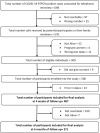Characteristics and predictors of Long COVID among diagnosed cases of COVID-19
- PMID: 36538532
- PMCID: PMC9767341
- DOI: 10.1371/journal.pone.0278825
Characteristics and predictors of Long COVID among diagnosed cases of COVID-19
Abstract
Background: Long COVID or long-term symptoms after COVID-19 has the ability to affect health and quality of life. Knowledge about the burden and predictors could aid in their prevention and management. Most of the studies are from high-income countries and focus on severe acute COVID-19 cases. We did this study to estimate the incidence and identify the characteristics and predictors of Long COVID among our patients.
Methodology: We recruited adult (≥18 years) patients who were diagnosed as Reverse Transcription Polymerase Chain Reaction (RTPCR) confirmed SARS-COV-2 infection and were either hospitalized or tested on outpatient basis. Eligible participants were followed up telephonically after four weeks and six months of diagnosis of SARS-COV-2 infection to collect data on sociodemographic, clinical history, vaccination history, Cycle threshold (Ct) values during diagnosis and other variables. Characteristics of Long COVID were elicited, and multivariable logistic regression was done to find the predictors of Long COVID.
Results: We have analyzed 487 and 371 individual data with a median follow-up of 44 days (Inter quartile range (IQR): 39,47) and 223 days (IQR:195,251), respectively. Overall, Long COVID was reported by 29.2% (95% Confidence interval (CI): 25.3%,33.4%) and 9.4% (95% CI: 6.7%,12.9%) of participants at four weeks and six months of follow-up, respectively. Incidence of Long COVID among patients with mild/moderate disease (n = 415) was 23.4% (95% CI: 19.5%,27.7%) as compared to 62.5% (95% CI: 50.7%,73%) in severe/critical cases(n = 72) at four weeks of follow-up. At six months, the incidence among mild/moderate (n = 319) was 7.2% (95% CI:4.6%,10.6%) as compared to 23.1% (95% CI:12.5%,36.8%) in severe/critical (n = 52). The most common Long COVID symptom was fatigue. Statistically significant predictors of Long COVID at four weeks of follow-up were-Pre-existing medical conditions (Adjusted Odds ratio (aOR) = 2.00, 95% CI: 1.16,3.44), having a higher number of symptoms during acute phase of COVID-19 disease (aOR = 11.24, 95% CI: 4.00,31.51), two doses of COVID-19 vaccination (aOR = 2.32, 95% CI: 1.17,4.58), the severity of illness (aOR = 5.71, 95% CI: 3.00,10.89) and being admitted to hospital (Odds ratio (OR) = 3.89, 95% CI: 2.49,6.08).
Conclusion: A considerable proportion of COVID-19 cases reported Long COVID symptoms. More research is needed in Long COVID to objectively assess the symptoms and find the biological and radiological markers.
Copyright: © 2022 Arjun et al. This is an open access article distributed under the terms of the Creative Commons Attribution License, which permits unrestricted use, distribution, and reproduction in any medium, provided the original author and source are credited.
Conflict of interest statement
The authors have declared that no competing interests exist.
Figures
References
-
- WHO Director-General’s opening remarks at the media briefing on COVID-19–30 March 2020 [Internet]. 2020 [cited 2021 Dec 13]. Available from: https://www.who.int/director-general/speeches/detail/who-director-genera....
-
- WHO Coronavirus (COVID-19) Dashboard | WHO Coronavirus (COVID-19) Dashboard with Vaccination Data [Internet]. 2021. [cited 2021 Dec 13]. Available from: https://covid19.who.int/.
-
- World health organization. The latest on the covid-19 global situation & long-term sequelae [Internet]. 2021. [cited 2021 Dec 13]. Available from: https://www.who.int/publications/m/item/update-54-clinical-long-term-eff....
MeSH terms
Substances
Associated data
LinkOut - more resources
Full Text Sources
Medical
Miscellaneous



